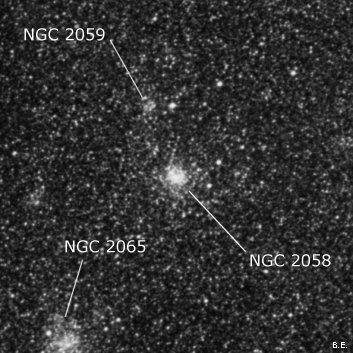
James Dunlop probably discovered NGC 2058 = D 103 on 24 Sep 1826 and described "a A round well-defined nebula, 30" diameter, bright at the centre. The preceding of three nebulae forming a triangle" He made a single observation and his position is just 3.7' NW of the cluster. On 11 Nov 1836, John Herschel called this cluster (h2933), "B; R; gbM; 90"; the 3rd of a group of 6." Three sweeps later he observed the cluster again as "vB; R; the 3rd of a group of 7. Pl IV, fig 9." His position and sketch is accurate. John Herschel equated Dunlop 102 with h2933, which Dunlop described as "a faint ill-defined nebula, perhaps 3' diameter". The large size, though, makes this identification unlikely.
The entire group of clusters (NGC 2046, 2047, 2057, 2058, 2059, 2065, 2066) was sketched by Le Sueur on 7 Feb 1870, Joseph Turner on 26 Apr 1876 and Pietro Baracchi on 18 Dec 1884 using the 48" Great Melbourne Telescope. Le Sueur's and Turner's sketches were published in "Observations of Southern Nebulae made with the Great Melbourne Telescope 1869 - 1885" in plate IV, figure 32 and figure 33.
600/800mm - 24" (4/9/08 - Magellan Observatory, Australia): this is the brightest cluster in a 15' field of 8 NGC clusters including NGC 2046, 47, 57, 59, 65, 66 and 72. All 8 clusters easily fit in the field of 13mm Ethos at 200x within a 20' circle. Using 260x, NGC 2058 appeared very bright, large, well concentrated. The outer halo extends up to 2' diameter using averted vision. At 350x, a few very faint stars are resolved in the halo and around the edges of the core. Two mag 12.5-13 stars lie 1' WSW and 1.5' WNW. Other nearby clusters include NGC 2059 2' N, NGC 2066 4.1' E, NGC 2047 5.4' WSW and NGC 2065 5.8' SE. I also picked up a couple of "anonymous" clusters or HII knots. OGLE-CL LMC 632 is north of NGC 2059 and LHA 120-N171B is following NGC 2072. This group of clusters is located just over a degree south of the Tarantula Nebula.
Notes by Steve Gottlieb